Troop 8 Paddles the Enchanting and Challenging Congaree
As Wyatt Pockl and Jackson McMichael paddled along a creek in Congaree National Park, they ducked under low-hanging tree branches. They could lift some branches out of the way, but that presented a risk.
After moving one, a footlong snake dropped out of the tree and landed on Wyatt’s knee.
“I thought he was going to jump out of the canoe,” Jackson recalls.
“I wasn’t — there were more snakes in the water!” Wyatt says.
Dodging nonvenomous water snakes wasn’t the only challenge Troop 8 of Columbia, South Carolina, faced during its weekend canoe trip this past April. But despite the challenges, the guys learned a lot and had fun in a beautiful park.
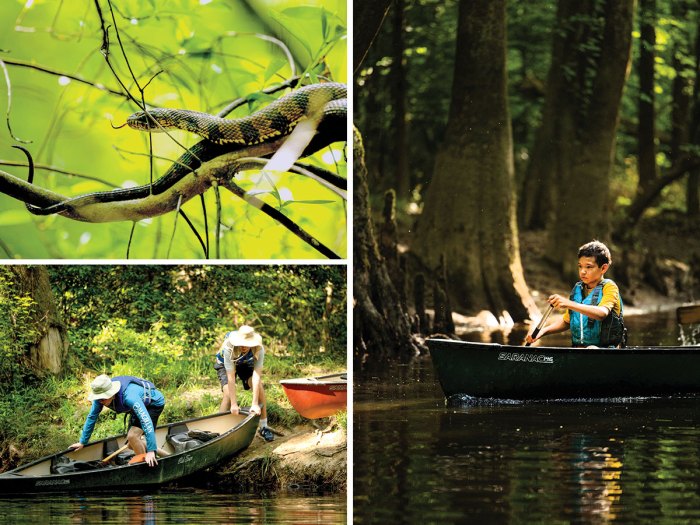
Top left: The troop saw a lot of wildlife in Congaree National Park, including this brown water snake. Bottom left: Seth Perry, left, and Evan Livengood prepare to launch their canoe. Right: Everett Schaller paddles.
TOTALLY SWAMPED IN CONGAREE
Congaree National Park in South Carolina features more than 26,000 acres, mainly of bottomland forest. These forests grow in places that flood often, creating boggy, shady environments ideal for many animals. Congaree attracts deer, foxes, beavers, alligators, amphibians and birds.
It also attracts adventurers who love to fish, hike and canoe. Troop 8 had been to the park before — it’s the largest old-growth bottomland forest in the Southeast U.S., with some trees growing 170 feet tall. And it’s only a one-hour drive from where the troop meets.
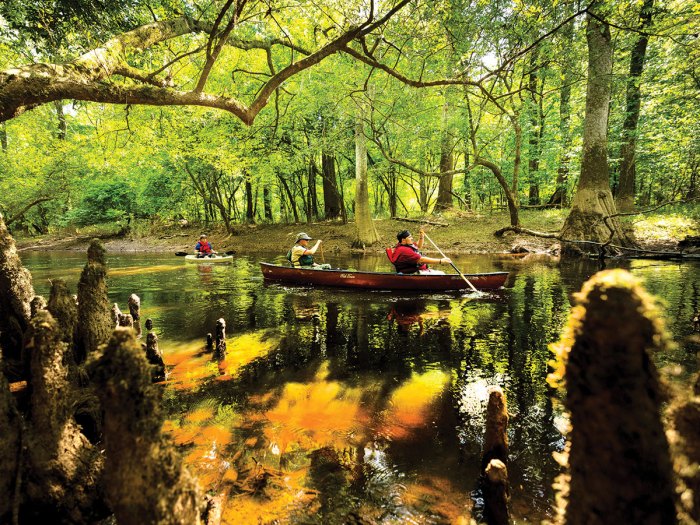
Josh Putnal paddles at the bow of his canoe while Scoutmaster Kirby Shealy handles steering from the stern. Behind them is adult leader Jeff Pockl.
“It’s an amazing place,” says Jackson, 14, a Star Scout. “There’s all sorts of greenery.”
This time, the troop would canoe a little over 6 1/2 miles. The plan could’ve changed quickly based on the river levels. On average, Congaree floods 10 times a year, submerging many of the park’s trails.
The troop’s leaders would need to watch the weather closely both before and during the campout.
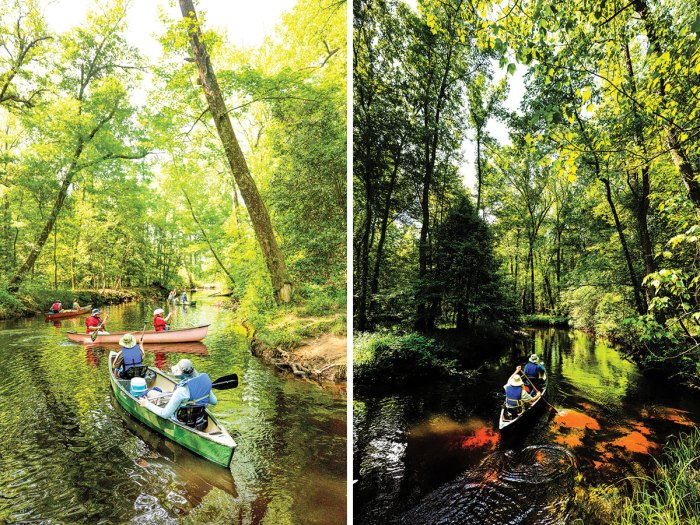
ON THE WATER
After reviewing safety rules and properly putting on their life jackets, the Scouts launched their canoes. Where you sit determines your role: Most of the steering is done from the back (or stern) of the boat while the pace is set in the front (or bow).
“I could be a lot faster with the paddle when I’m up front,” says Noah Putnal, 12, a Tenderfoot Scout.
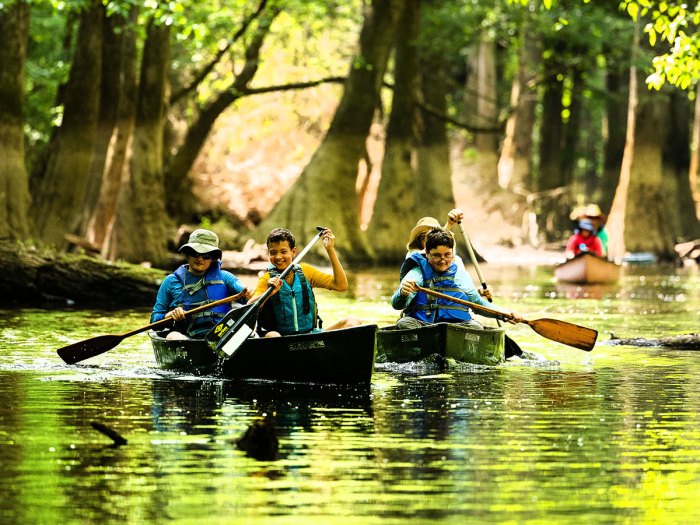
Seth Perry, Everett Schaller, Jackson McMichael and Evan Livengood steer their canoes through Congaree National Park.
When you’re tandem canoeing, you have to work together. If you’re both paddling on the same side of the boat, you won’t travel straight. Communication is key, so you can move effectively and in unison.
“I like being in the front because it’s where the power of the boat is,” says Everett Schaller, 12, a Tenderfoot Scout. “We learned the J-stroke and the draw stroke.”
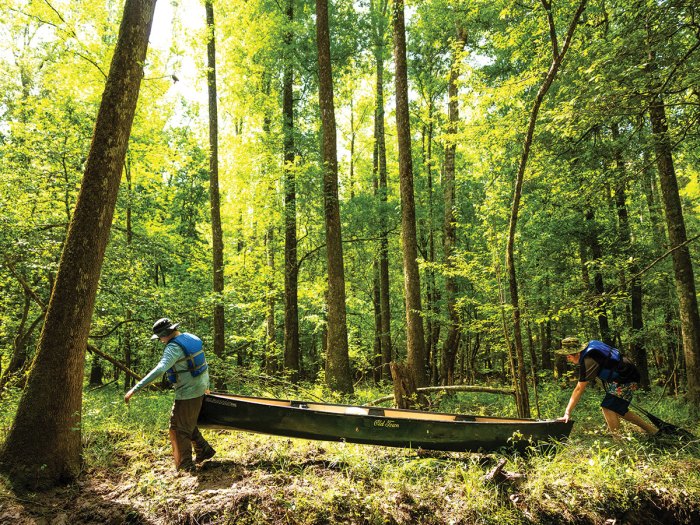
Jackson McMichael and Wyatt Pockl carry their canoe.
Knowing different strokes makes it easier to maneuver, and the guys had to figure out how to move in the narrow creek with overhanging branches and clogged pathways. Sometimes, they had to slow down when approaching piles of wooden debris.
“It took us 10 minutes to get through like 5 feet of that,” says Wyatt, 13, a First Class Scout. “It was like a knife through ice. We powered through, but it was hard.”
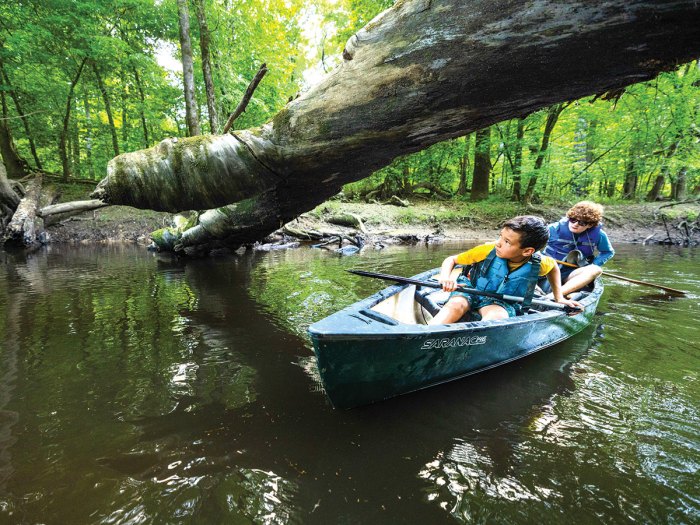
Everett Schaller, left, and Seth Perry cruise underneath a tree.
They didn’t give up. When a nonvenomous snake fell in one of the canoes, they simply paddled to shore to let the slithering reptile out. When downed logs blocked the path, the guys hopped out and carried their canoes (called “portaging”).
“We were able to keep going, no matter what was in our path,” Jackson says. “We never said, ‘Stop — we don’t want to do this anymore.’ A Scout never quits on his dreams.”
The guys were rewarded later as the creek widened and fewer obstacles littered the water. They could paddle more freely and quickly, even taking off for a fun race.
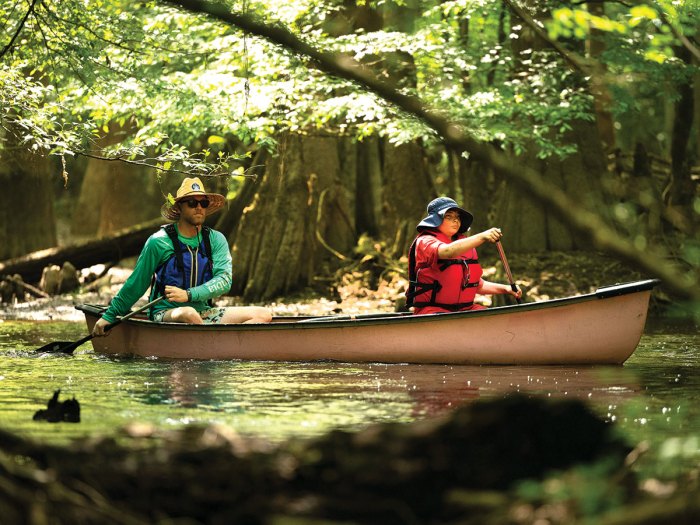
Noah Putnal, right, guides his canoe with adult leader Adam Fenton.
WORK LIKE A TEAM
The Scout motto is “Be Prepared.” Monitoring the weather, the troop knew it was supposed to rain before they left. To make packing up easier, they started that evening after dinner instead of waiting until morning and packing in the rain. It was a great idea, but like paddling, you need to work as a team so the task goes smoothly.
Some Scouts tried carrying heavy equipment back to the troop trailer by themselves. Struggling with the gear quickly became frustrating, and they soon learned a lesson.
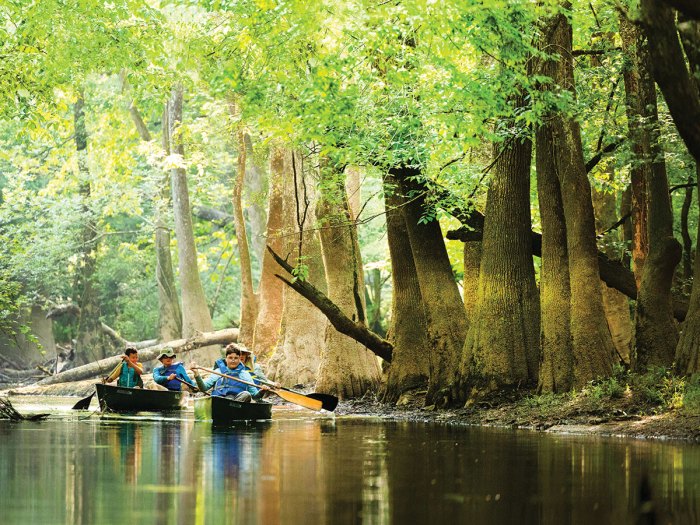
Jackson McMichael and Evan Livengood navigate their canoe across the calm waters of Cedar Creek. Behind them, at left, are Everett Schaller and Seth Perry.
“Many hands make light work,” Wyatt says.
It’s OK to ask for help, even when you’re a leader. A troop is a team, and everyone can contribute to solving problems and completing tasks. When you work together, you can all Be Prepared.
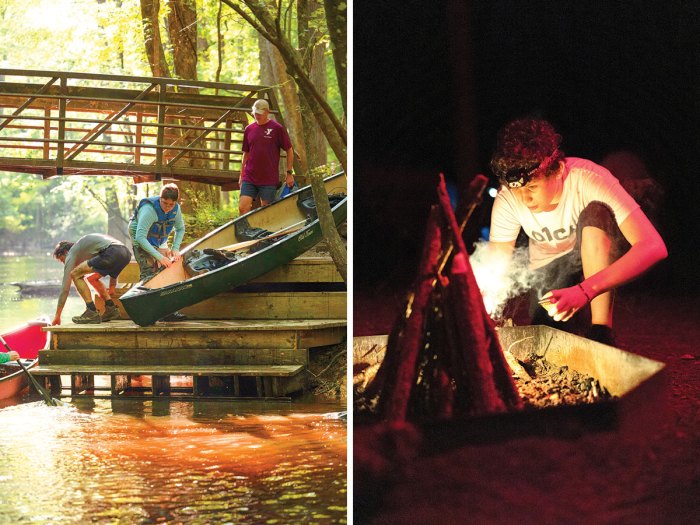
Jackson McMichael, center, helps adult leaders Adam Schor and Craig Perry take the canoes out of the creek. Right: Wyatt Pockl works on lighting a campfire.
Boating Fun
Scouting America offers several boating awards, from merit badges like Canoeing, Rowing and Small-boat Sailing, to special awards, including Kayaking and Whitewater Rafting. These awards are for older Scouts, Sea Scouts, Explorers and Venturers.
Most boating activities are for older Scouts, though Cub Scouts can ride or paddle in canoes, kayaks and other boats on calm water.
Before you get on the water, follow the proper safety rules as outlined in the Guide to Safe Scouting.
The Right Moves
Whether you’re weaving around logs or cruising on flat water, canoeing is a lot easier when you know how to paddle. Use these paddling strokes to guide your boat where you want to go:
Forward stroke — Helps you go forward. Place the paddle in the water and draw it back.
Backstroke — Helps you stop or move backward. Place the paddle in the water, keeping it vertical and pushing it forward.
Draw stroke — Moves the canoe sideways, toward the paddling side. Place the paddle far from the boat and draw it to you.
Pushaway stroke — Moves the canoe sideways, away from the paddling side. Place the paddle close to the boat and push it away from you.
Forward sweep — Turns your canoe. Create an arc with the paddle starting in front of you, which swings the canoe around.
Reverse sweep — Turns your canoe. Create an arc with the paddle starting behind you, which swings the canoe around the other way.
J-stroke — A forward stroke that counteracts any drifting, keeping you going straight. The paddling motion looks like the letter “J.”
Leave a Comment